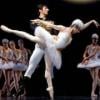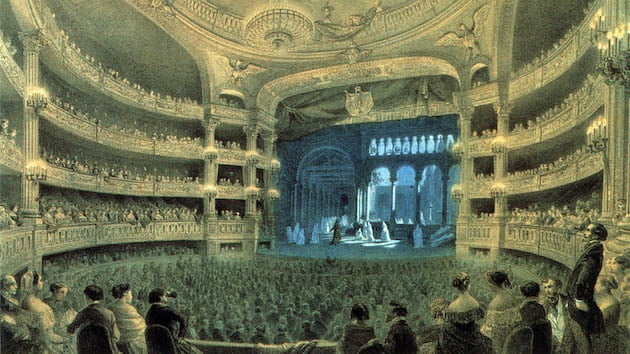
With their themes of love, loss, and yearning for spiritual transcendence — not to mention their iconic white-tulle costumes — La Sylphide and Giselle have come to define Romantic-era ballet. Nearly two centuries since their Paris premieres — Filippo Taglioni’s La Sylphide in 1832 and Jean Coralli and Jules Perrot’s Giselle in 1841, essentially bookending ballet’s Romantic period and coinciding with the Early Romantic period in music — they still capture our imaginations and break our hearts.
Giselle and La Sylphide define Romantic ballet for modern audiences. Yet they represent only two of the many ballets created between 1830 and 1845, the period’s traditional range; new story ballets were choreographed and performed all over Europe, typically telling tales of adventure, historical events, young love, and the lifestyles of the rising bourgeoisie. Nevertheless, Giselle and La Sylphide beautifully illustrate how the earthbound materials and mechanical technologies of the period captured and embodied the Romantic zeitgeist. And examining the materials and musical instruments of the era yields marvelous insights into how ballets were performed and what experiencing them may have been like for audiences of the time.
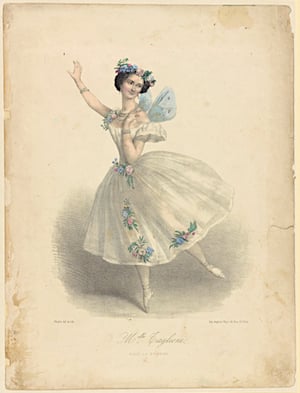
The costumes from Act II of Giselle provide an archetypal example. Act II takes place in a dark forest in Germany, where the Wilis, the spirits of young maidens who were betrayed by men and died before they could marry, rise after dark to hunt down and kill any men foolish enough to venture into the forest at night. Giselle and her Wili sisters wear skirts of wafting white tulle, which create an airy, hovering effect as they dance and a spectral translucence that is enhanced by gloomy stage lighting. Emblematic of Romantic-era aesthetics and staged essentially the same way today, the scene embodies the era’s emphasis on folk beliefs, spirituality, connection to nature, longing, and sorrow, along with a touch of Gothic-revival horror.
Those evocative skirts actually made their ballet debut a decade earlier, at the Académie Royale de Musique (aka the Opéra de Paris) in Giacomo Meyerbeer’s 1831 opera Robert le diable. In Act III, the questing knight Robert visits the ruins of a cloister at night. The spirits of deceased nuns, portrayed by corps de ballet dancers wearing tulle skirts and illuminated by innovative gaslights (in one of their first uses onstage), rise from their graves to tempt and taunt him. They caused a sensation among theatergoers, apparently because of their spectacular eeriness as well as the revelation of their silhouetted legs through the illuminated semi-opaque fabric.
It was a turn-of-the-19th-century invention of the 19th century that tulle could be produced efficiently and affordably enough for large-scale theatrical use. Before then, tulle lace was hand woven on bobbins, a laborious and time-consuming process that made the fabric precious and extremely costly. Today’s costumers use 25 to 30 yards of tulle to make a single Romantic-style tutu, so an Act II cast that includes Giselle, Myrtha the Queen of the Wilis, and a corps of, say, 24 Wilis, would require 650 to 780 yards — even if the costumes for the original production of Giselle were made with, say, half as many layers, they would require far more fabric than could be made by hand on short order, much less at a reasonable cost. But in 1808 John Heathcoat invented the bobbinet machine, which could turn out net fabric much more quickly than human hands. Technical improvements over the following two decades enabled larger-scale production in time for Romantic costumers to devise the era’s signature look.
Nascent pointe technique contributed to the magical effects of both ballets as well. While today’s pointe shoes are made with rigid shanks and hard, blocked toe boxes that provide strong support for dancing on tiptoe, no such shoe technology existed in 1832, when La Sylphide premiered in Paris with principal dancer Marie Taglioni in the lead. Taglioni wore the typical ballet slippers of the era, crafted from soft satin with semi-stiff full leather soles, and simply darned around the sides and tips to create a bit of padding for her toes. Her brief poses on pointe emphasized the ethereal quality of the title character, an alluring, winged sprite who tempts a young Scotsman named James away from his betrothed, Effie, on the eve of their wedding.
E. A. Théleur’s 1831 Letters on Dancing, depicts women posing on the tips of their toes in soft shoes, and several books outline exercises for developing the strength of the insteps to enable tiptoe movements. Earlier toe dancing on stage essentially comprised virtuosic tricks meant to dazzle the audience; what made Taglioni’s pointe work in La Sylphide groundbreaking was that it was utilized to express the essence of the Sylph’s character rather than simply to dazzle the eye. In 1841, the Italian ballerina Carlotta Grisi would employ similar pointe work as the first-ever Giselle, to the same effect.
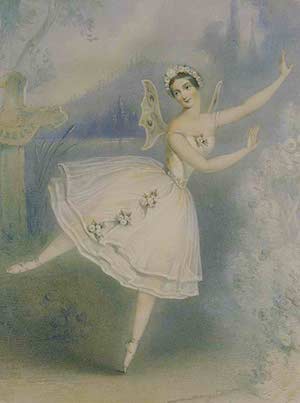
Ballet music was evolving as well, with Early Romantic composers beginning to write original scores for ballets rather than simply repurposing familiar airs from operas. The music is so evocative and colorful that today that it is sometimes performed in instrumental concert settings that are devoid of dancers; musicians and audiences are simply left to imagine how dance might enhance the experience and expression of the music. Student musicians sometimes learn famous Early Romantic pieces without even realizing that they are based on dance forms. But it is entirely possible to gain a sense of the utterly sensate, dynamic collaboration between musicians and dancers of the early 19th century by plumbing a treasure trove of historical materials.
The Early Romantic soundscape was created by instruments that were constructed differently, and sounded different, from those commonly in use in today’s ballet orchestras. Modern innovations in strong bow design weren’t yet standardized; overall, bows of the period tended to be more flexible and articulate than today’s bows. Until around World War I, strings were made of cleaned, dried, and stretched sheep gut (or metal wound around that material); gut strings are typically more supple and responsive than modern metal strings. Wind-instrument builders began to experiment with bore size and shape, or the number and function of keys. Design experiments for horns, such as the addition of valves, were just beginning. The gorgeous balance of these wind and string instruments produced a brilliant variety of tone color, and the versatility of a true Early Romantic instrument ensemble complements the dramatic qualities of dance in different ways than an orchestra playing the same score on modern instruments is able to do.
We can also draw on abundant collections of original music manuscripts that reveal the kinesthetic relationship between dancers and musicians. Specific examples of stenography from the era show us exactly how the dance and the music align: Here, a popular opera or concert piece might be repurposed as a pivotal moment in a story ballet; there, a familiar (and difficult!) etude for solo violin becomes a warm-up exercise in a ballet class. By playing the original music for dancers familiar with early 19th-century ballet technique, we can see how a dance class was structured, follow the sequence of the dancer’s training regime, and envision how professional dancers moved across the stage to the music. A living line between the music and the dance is drawn before our eyes.
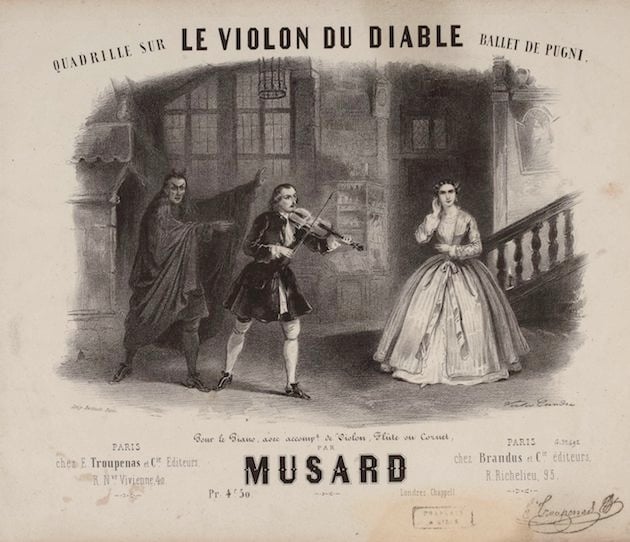
Adding to the rich store of manuscripts are scholarly, well-researched personal histories of the era’s famous dancers, choreographers, and musicians. The ballet master again provides a helpful example. From the 15th century well into the 19th century, the dance master was a musician, or at least a violinist of sufficient skill to accompany the class exercises and presided over the juncture of music and dance at court and in the theater. Arthur Saint-Léon exemplified this type of multi-talented professional. A virtuoso violinist, celebrated ballet dancer and choreographer, and eventually the dance master for the Imperial Russian Ballet, he was celebrated throughout Europe. In a scene from his 1849 ballet Le Violon du Diable (The devil’s violin) — a two-act Faustian tale of a violinist who sells his soul, with an original score by Cesare Pugni — Saint-Léon danced the lead role, partnering his then-wife, the famous ballerina Fanny Cerrito, and played the violin. It is a shame that so little of Saint-Léon’s oeuvre survives — a pas de six from the 1844 one-act romance La Vivandière and the libretto for the 1870 full-length comedy Coppélia — as his mastery of the performing arts of his time was so thorough.
Although we live in very different times, both culturally and technologically, with such a rich historical legacy in materials and research at our fingertips, we can summon the look, sound, emotional qualities, and underlying beliefs of Romantic-era ballet performance. Exploring the context in which the ballets arose offers insight into their complexity, and helps us question contemporary assumptions about the choreography, librettos, and music that have survived. By pairing imagination with historical awareness, we can rediscover the experiential aspects of dance and music and gain insight into these arts as we practice them today.
*The authors would like to thank Sandra Noll Hammond for her scholarly review.




